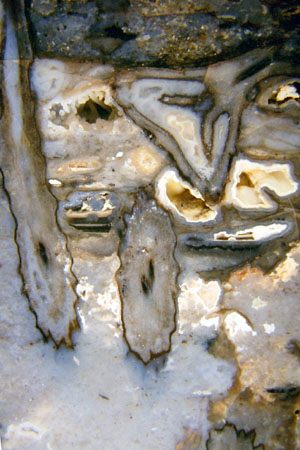 Horneophyton
Horneophyton
Photograph: Rhynie chert, level bands in cavities indicating the
orientation,
poorly preserved upright Horneophyton
shoots, shrunk and crumpled, one with forking central strand,
another shoot upset, pointing downward with sporangium at the top,
two lobes with columella seen here, other ones possibly cut away or
hidden in the depth.
Horneophyton
is distinguished by at least three unique features:
1. Its sporangia are of such an irregular and variable shape that
nobody seems to be able to tell whether they should be regarded as
several sporangia fused into one or as one sporangium branching into
several lobes, every one with its separate small opening.
2. There is a kind of central stalk inside the sporangium, called
columella, which is branched like the sporangium itself.
3. Horneophyton
grows tubers, often in a string where they can fuse laterally
into a short
rhizome.
ad 1: Contrary to evidence, Horneophyton
sporangia are usually pictured
with neat regular shapes [1], Fig.8.40.
For details see Rhynie
Chert
News 15.
ad 2: A distinct columella inside the sporangium is a charactersitic
feature of the hornworts. In the case of Aglaophyton, the
central
strand of the stalk extends a little bit into the sporangium where it
forms a small mound. It is not known whether the columella in
Horneophyton
and hornworts and the mound in Aglaophyton
are mutually
related in a phylogenetic sense.
ad 3: Horneophyton
is still described as having a tuber [1] although it has become known
that often it has got a
rhizome consisting of adjacent tubers [2].
For more about these
tubers see Rhynie
Chert
News 27, 79, 81.
For Horneophyton
spore tetrads see Rhynie
Chert
News 45, 150.
Note also the corrections under the heading "Errors".
H.-J.
Weiss
last updated 2016, 2019
[1]
T.N. Taylor,
E.L.Taylor, M. Krings: Paleobotany, Elsevier 2009.
[2] H.
Hass, H.
Kerp:
Rhynie chert plants and their substrates. Conference "The
Rhynie Hot Spring System", Aberdeen 2003.
